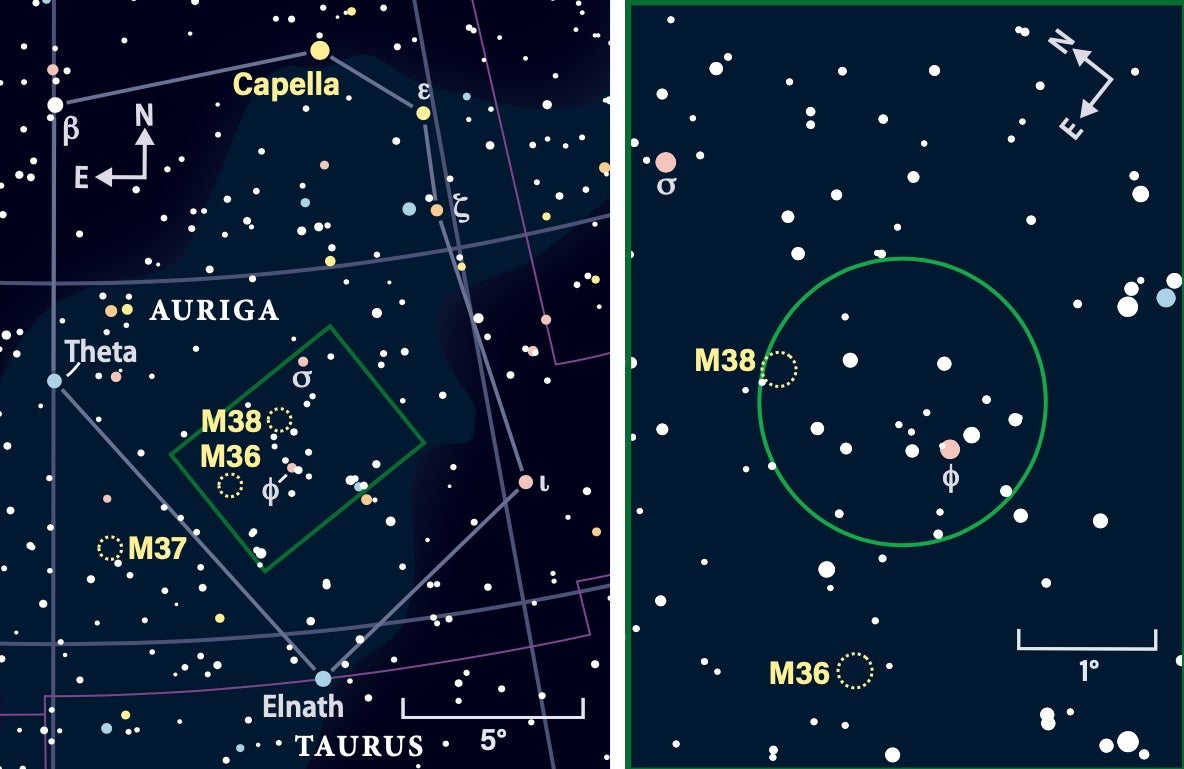
Even though winter doesn’t officially begin until Dec. 21, one glance at the current evening sky shows that it is on its way. The 20th century’s preeminent deep-sky author, Walter Scott Houston, once wrote of the late autumn sky, “The celestial actors are in place, a serene majesty washes over the stage, and I can hear the music of galactic trumpets in their opening bar. What better time to observe the splendor of the heavens?”
The first of the season’s many bright celestial actors, Capella (Alpha [α] Aurigae), ushers in winter’s first act. It brings with it a collection of striking binocular targets stashed within its constellation, Auriga the Charioteer.
Capella, at magnitude 0.08, is the sixth brightest star in the sky and lies approximately 43 light-years from Earth. It’s a dazzling sight through binoculars. Although it looks like a single point, the star we see is a binary system made up of two closely set yellow giants. View Capella high in the sky and you might see the faintest hint of yellow.
As it passes centrally through Auriga, the Milky Way brings several open star clusters that are eager to show themselves through binoculars. The brightest three hold sequential spots in Charles Messier’s catalog — M36, M37, and M38 — although he did not discover any of them. All were first spotted by Giovanni Battista Hodierna. Using a simple 20x refractor, he cataloged 40 nebulous objects. Hodierna published those observations in 1654.
All three objects fit into the same 7°-wide field of view. If you are using 10x or lower-powered binoculars, once you spot one, you might be able to catch all at once.
Let’s start our tour with a smile. If you aim 6° due north of Elnath (Beta [β] Tauri), the tip of Taurus’ western horn, you’ll find an arc of six 5th- to 7th-magnitude stars curving northeast to southwest. The brightest is 5th-magnitude Phi (φ) Aurigae. To the arc’s west are two other 6th-magnitude stars. Together, they form an asterism known to many as the Happy Face. I sometimes imagine it as Shirley Temple, the dimpled child star of the 1930s, because our heavenly grin also has a hazy dimple just off the northernmost star in the smile.
That dimple is actually the open cluster M38. Look for what seems like a cotton ball two-thirds the size of the Full Moon floating in a starry field. Over 100 suns make up M38, although the brightest only rank 7th magnitude. Naturally, the larger the binocular, the greater the number of stars seen. Those viewing through 70mm or larger binoculars may notice that some of the stars form a cross or an X against the glow of unresolved starlight.
Just 2.3° southeast of M38, we come to M36. M36 appears smaller than M38. Its stars, however, are brighter, which makes it easier to resolve. Depending on local sky conditions as well as the size and quality of your binoculars, you might be able to spot more than half a dozen faint stars within its round, misty glow. Through giant binoculars and telescopes, some of the cluster stars appear to line up in curves that hook away from the center, leading to M36’s nickname, the Pinwheel Cluster.
Our final scene is just beyond the southeast side of Auriga’s pentagonal frame. M37 is the brightest of the three Messier objects here, although it can be challenging to find. Aim just east of the halfway point on a line between Elnath in Taurus and Theta (θ) Aurigae.
M37 is also the richest of the three Messier objects here, with over 1,800 stars calling it home. But because most are fainter than 10th magnitude, it’s also the most difficult to resolve. Most binoculars show a large circular glow against a star-filled field. My 16×70 binoculars begin to add a granularity to the glow as dimmer inhabitants begin to appear. That glittery appearance resulted in M37 being nicknamed the Salt and Pepper Cluster.
Questions, comments, suggestions? Contact me through my website, philharrington.net. Until next time, remember that two eyes are better than one.









